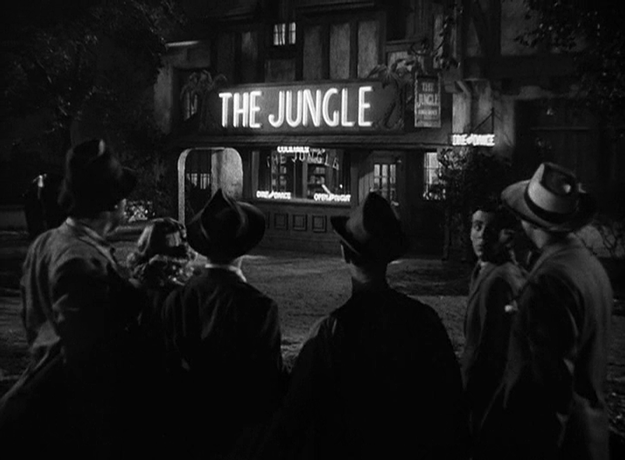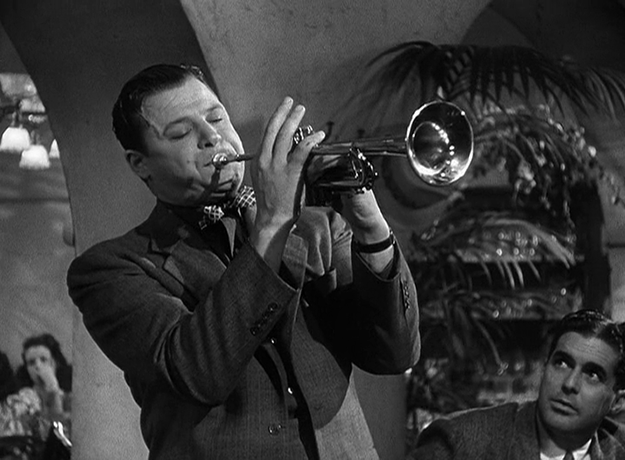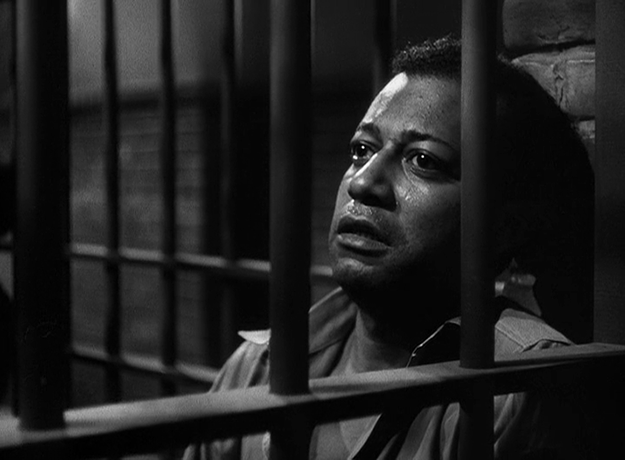Blues in the Night was released in a sweet spot just before the bombing of Pearl Harbor (22 days prior, to be precise), when studio/government saber-rattling was ramped up but before American war entry, when rah-rah propaganda to support the effort became nearly obligatory. The timing might help explain the film’s loose-leash oddness—the unique mashing of genres (noir, musical, melodrama) that makes it close to sui generis. There are later films that amalgamated musical and noir elements, including The Hard Way (also featuring Jack Carson), To Have and Have Not, with its swell Hoagy Carmichael tunes, Gilda, Glory Alley, et al., but Blues in the Night was pioneering, arriving so early in the classic noir period. The music, mostly by Harold Arlen, with lyrics by Johnny Mercer, is built into the plot (characters don’t spontaneously break out in song as in a straight-up musical), but very rare is the noir that is so tune-focused. And it’s not just lazily tagged “noir” because it came out in 1941 and has some shadows, guns and a dark femme fatale (contrasted with an upstanding blonde)—there are some authentic psychic ills plumbed here, particularly in the surreal, alarming montages crafted by the great Don Siegel. That mental breakdown montage arrives late in the film, but its visions of the broken-down piano-playing bandleader Jigger Pine (the Victor Mature-like Richard Whorf) are presaged in the film’s first scene. A drunken St. Louis nightclub patron makes a boorish song request, and while that can’t be the first time that’s happened, the proud, thin-skinned Jigger responds by decking him, twice. The ensuing riot lands the whole band in jail, and the chaos leads naturally into Jigger and the band’s rough travels. Freight-hopping later to another gig, the band meet escaped con Del (Lloyd Nolan), who sticks them up before being won over. Del engages the band at seedy Jersey gambling shack The Jungle, a nest of nefarious types including tone-deaf chanteuse Kay (Betty Field). The scheming Kay, who also tries to woo Leo, becomes Jigger’s downfall after his ill-starred attempt to turn her into a proper singer, like Charles Foster Kane with Susan.
As Jigger makes his way through the travails of the noir, there are additional double-crosses, murders, a miscarriage and a rain-soaked, climactic suicidal-homicidal drive off a cliff, all juggled cleanly by director Anatole Litvak. The Russian-born Litvak had already made musicals in Germany, dramas in France and crime and noir pictures in America (where the Jewish director fled to escape the Nazis), and so was well-equipped to tackle Blues in the Night’s genre mélange. A musical highlight is the jailhouse jazz scene including clarinetist Nickie (Elia Kazan), drummer Peppi (Billy Halop), and bassist Pete (Peter Whitney), who is already bunked there. After a neighboring inmate warns that the hyperventilating Peppi is getting “the miseries,” he and his all-black cellmates launch into a haunting rendition of the title song, led by William Gillespie’s rich baritone. There’s some smuggled commentary about cultural appropriation as Jigger admiringly, almost lustily, eyes the singers, saying “That’s the lowdown New Orleans blues!”, as he and his band plot how to forge a career hawking jazz on the road. Blues in the Night is based on a Kazan retooling of an Edwin Gilbert play called Hot Nocturne, with the final screenplay fashioned by other soon-to-be director Robert Rossen. Litvak’s cool efficiency borders on the drab at times, however; ironically, Litvak’s failure to impress Kazan, who was also in Litvak’s James Cagney-starring drama City for Conquest (1940), inspired the future filmmaker, who declared, “I sure as hell can direct better than Anatole Litvak!” The actual razzle-dazzle is provided by Siegel, a true studio apprentice since his teens whose masterful montage work benefited films like Now, Voyager, The Roaring Twenties and Litvak’s Confessions of a Nazi Spy. A Siegel montage early on—maps and stock cotton-picking footage—spirits the band to New Orleans, where they recruit cocky trumpeter Leo (Carson) and his wife Ginger (Priscilla Lane), matter-of-factly nicknamed “Character.” But it’s the montage that visualizes Jigger’s DT mental hospital fever dream that is a marvel. In a terrifying cascade of dissolves, scored to atonal blare and creepy whispering, Jigger pictures himself as a tiny performing monkey, his giant bandmates taunting him, then sees Kay aggressively playing all the instruments, the sweaty “miseries” prisoner moaning and finally his piano keys turning into a gooey white paste in his hands. The montage is a surreal tour de force on the level of the Dali/Hitchcock dream sequence in Spellbound.
Siegel’s mini-movie would stick out awkwardly from the surrounding film if Litvak and Whorf (yet another future director) hadn’t properly laid the groundwork for Jigger’s psychic crisis. This is best established in a nightclub scene in which a gaudily tuxedoed Jigger, having abandoned his band to pursue Kay, is playing the goofy “Says Who, Says You, Says I,” while singer Mabel Todd pulls funny faces and a guy tap dances on Jigger’s piano, the ultimate indignity made worse by the fact that his former bandmates are in the audience, looking on sorrowfully. Litvak’s economized conjuring of pathos in that scene is matched throughout by cinematographer Ernest Haller’s corner-cutting use of fog and darkness, which in some instances obscure the recycling of sets from the same year’s Sergeant York. Haller, who also shot Gone With the Wind, Rebel Without a Cause and a slew of Bette Davis pictures, helps turn the sometimes shabby raw materials here into something moody and romantic, aided by the playing and bandleading of real-life jazz musicians like Jimmie Lunceford, Snooky Young, and Stan Wrightsman. Respect is due to Lane, an appealing screen presence with a Miriam Hopkins quality, for credibly doing her own singing (the other actors are dubbed) on the fun “Hang On to Your Lids, Kids.” It’s just one of a handful of toe-tappers in this oddball salad, a film which manages to be a choice entry in multiple genres. Blues in the Night airs February 3 on Turner Classic Movies. Justin Stewart is a writer whose work has appeared in Brooklyn Magazine, Reverse Shot and elsewhere.


